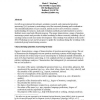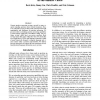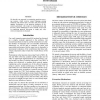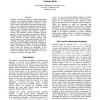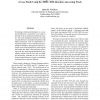NDQA
2003
14 years 26 days ago
2003
Early TREC-style Question Answering Systems were characterized by the following features: (a) the answer of the question was known to be included in a given local corpus, (b) the ...
NDQA
2003
14 years 26 days ago
2003
Growth in government investment, academic research, and commercial question answering (QA) systems is motivating a need for increased planning and coordination. The internationali...
NDQA
2003
14 years 26 days ago
2003
Current question answering systems succeed in many respects regarding questions about textual documents. However, information exists in other media, which provides both opportunit...
NDQA
2003
14 years 26 days ago
2003
We describe our approach in constructing question answering systems, which involves natural language parsing enhanced with named entity extraction and part-of-speech tagging. Perf...
NDQA
2003
2003
Combining Low-Level and Summary Representations of Opinions for Multi-Perspective Question Answering
14 years 26 days ago
1 While much recent progress has been made in research on fact-based question answering, our work aims to extend question-answering research in a different direction ─ to handle ...
NDQA
2003
14 years 26 days ago
2003
With the ever-increasing amount of textual information available, it is becoming increasingly unlikely that a single document will provide the answer to a question. A more likely ...
NAACL
2003
14 years 26 days ago
2003
Evaluating competing technologies on a common problem set is a powerful way to improve the state of the art and hasten technology transfer. Yet poorly designed evaluations can was...
NAACL
2003
14 years 27 days ago
2003
In this paper we investigate the use of surface text patterns for a Maximum Entropy based Question Answering (QA) system. These text patterns are collected automatically in an uns...
NAACL
2003
14 years 27 days ago
2003
The JAVELIN system integrates a flexible, planning-based architecture with a variety of language processing modules to provide an open-domain question answering capability on fre...
NAACL
2003
14 years 27 days ago
2003
Recent TREC results have demonstrated the need for deeper text understanding methods. This paper introduces the idea of automated reasoning applied to question answering and shows...

